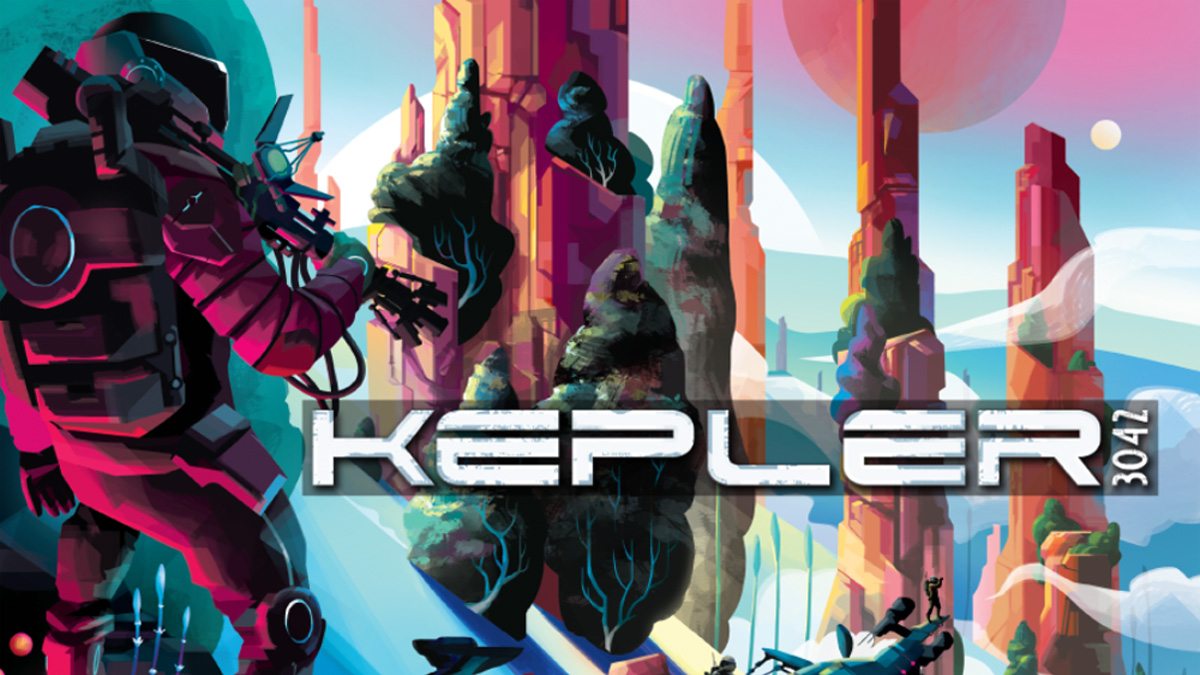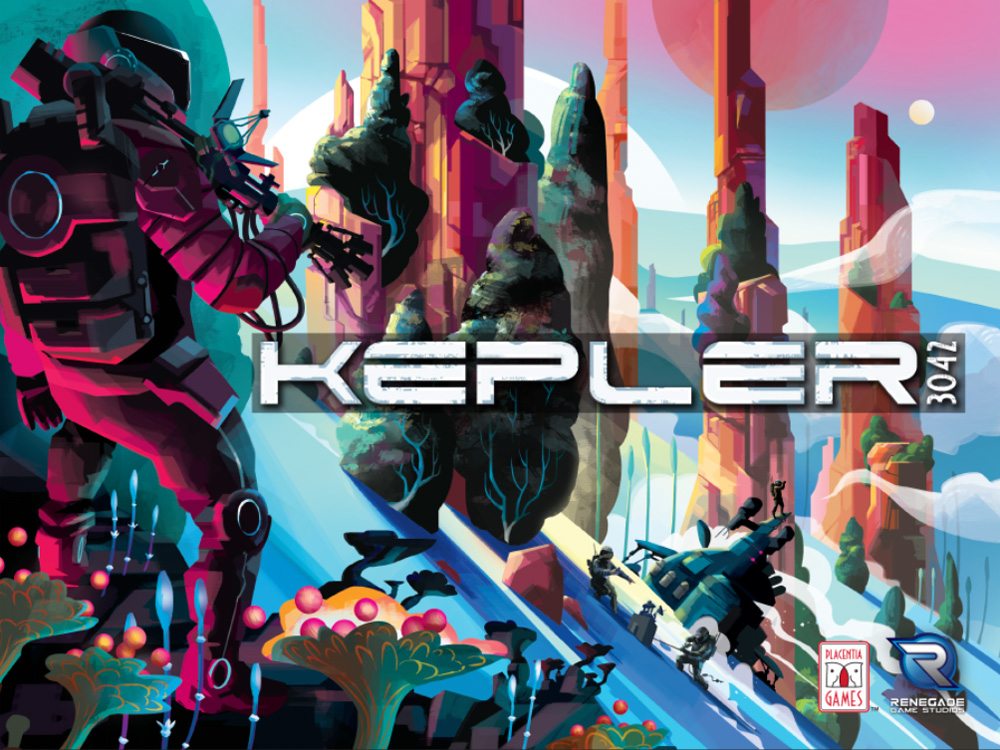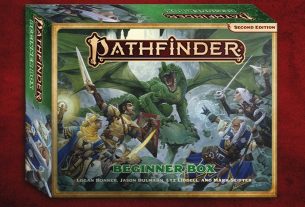In the year 3042, humanity has finally got its act together–we’re headed to the stars, finding planets to colonize and terraform. Perhaps more surprisingly, we’re not killing each other over it. Kepler 3042 is a space race: who will be the greatest pioneer in the final frontier?
What Is Kepler 3042?
Kepler 3042 is a space exploration game for 1 to 4 players, ages 14 and up, and takes 1 to 2 hours to play. It is currently available in stores and online, with a retail price of $65. The game can be long and does have some complexity, which is perhaps the primary reason for the 14+ age rating. However, kids who have some experience and the patience could play Kepler 3042–there isn’t really anything thematically inappropriate for kids.
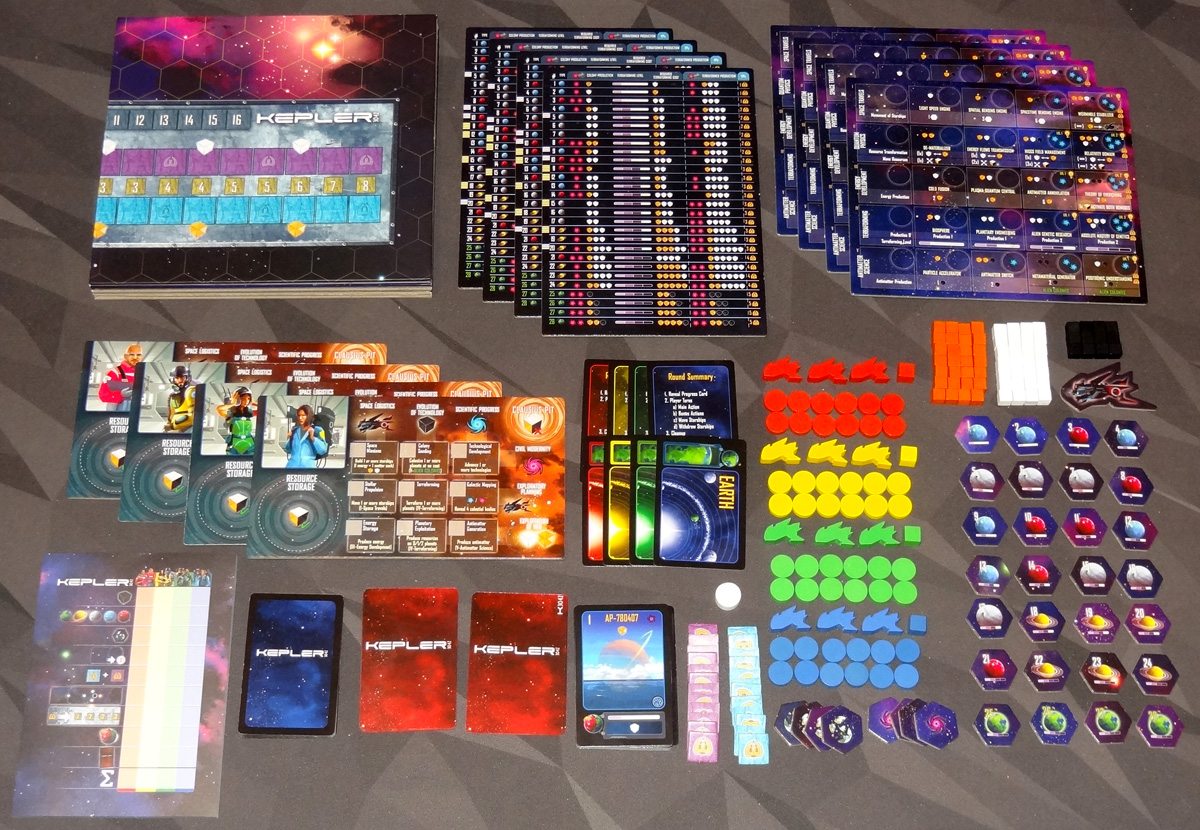
Kepler 3042 Components
- 36 celestial body tiles
- 24 medal tokens
- 12 colonial medals
- 12 technology medals
- 1 round marker
- 1 first-player marker
- 1 scorepad
- 1 galaxy board
- 17 objective cards
- 10 standard objectives
- 7 advanced objectives
- 18 progress cards
- 28 planet cards
- 4 technology boards (1 per player)
- 4 planet summary charts (1 per player)
- 4 Earth cards (1 per player)
- 4 reference cards (double-sided)
- 4 action boards (1 per player)
- 68 resource cubes
- 28 energy (orange)
- 28 matter (white)
- 12 antimatter (black)
- 48 nation markers (12 per player)
- 4 action cubes (1 per player)
- 12 starships (3 per player)
- 1 science supplement
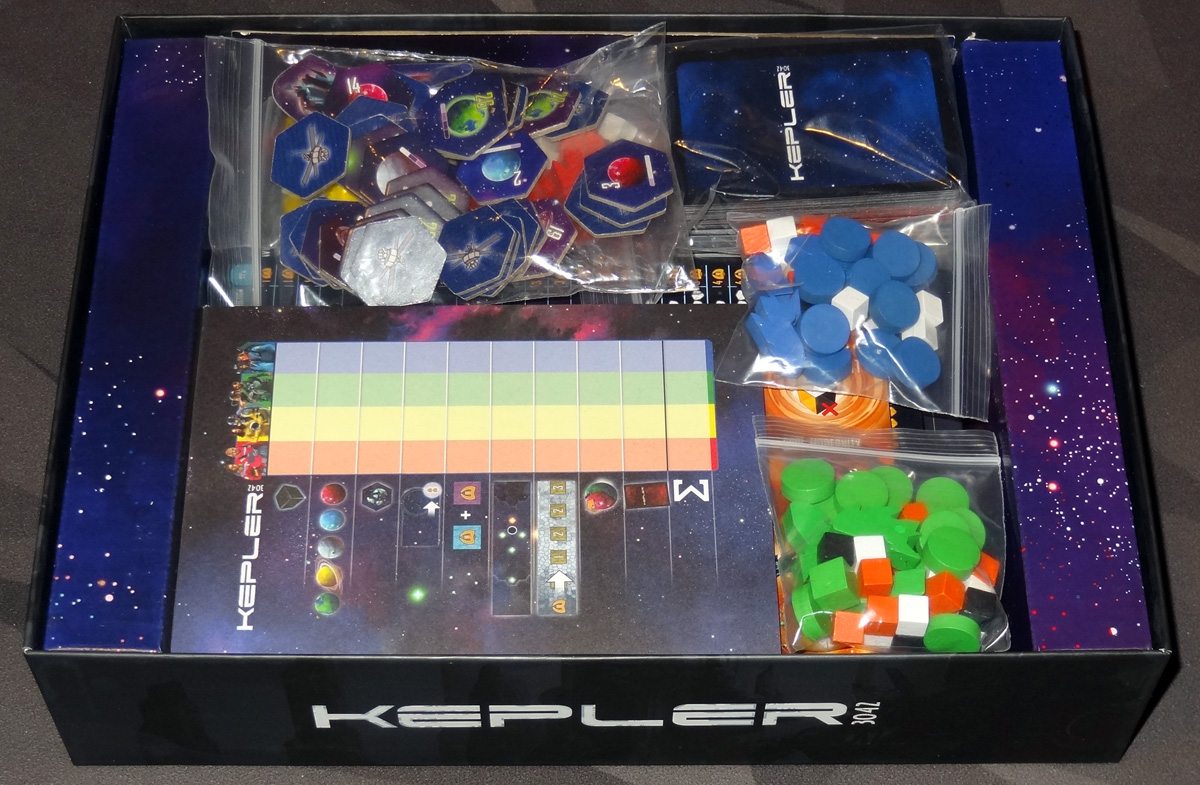
Kepler 3042 has a good deal of components: the materials fill up almost all of the box, which just has a simple cardboard insert that pads the two ends of the box. The board is quite large–it’s a 9-fold board, with most of it taken up by the hex-based space map. Each player will also end up with a couple of boards–an action board, a technology board, and a planet summary chart that is more of a reference sheet than an actual game component.
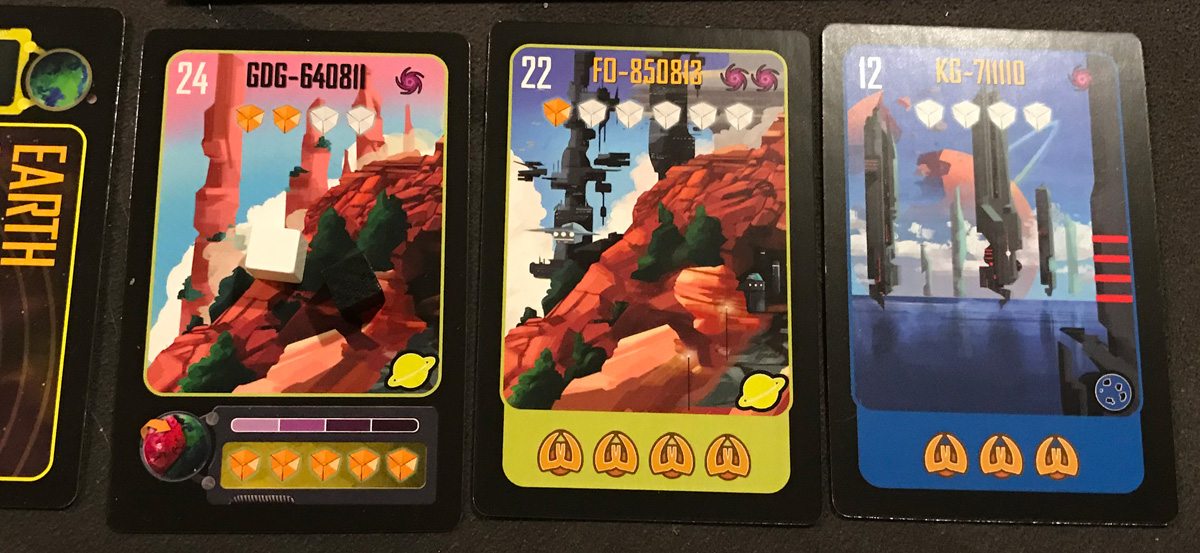
The wooden components are fine and fairly standard cubes and discs, except for the starship meeples, which are patterned after Kwanchai Moriya’s illustrations in the game. Speaking of which, I really dig his illustrations, but I wish there were more of them. They appear on the cover, parts of the player action boards, and the planet cards. On the planet cards, the illustrations are reused for each planet type, with an unterraformed and terraformed version of each type. But a lot of the rest of the game–the objective cards, progress cards, the game board–don’t have the illustrations, which can make the game seem a bit more dry.

There are some oddities to the design choices. For instance, the hex spaces on the board are arranged so that the flat sides are facing right and left on the board, with vertices facing up and down. But the planet tiles are printed so that the number is along a bottom face, meaning that there’s no way to place the tiles so that they’re oriented in the same direction as the board. There is also an abundance of very tiny text in this game, and I found that in some cases there are antimatter icons (black cubes) printed against dark blue, which makes them very easy to overlook.
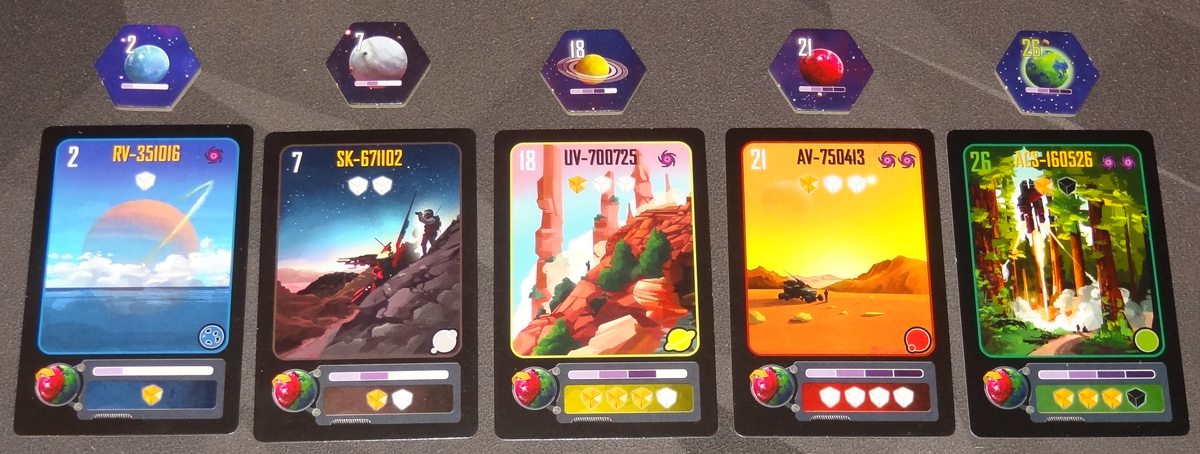
It might also have been nice to have the planet tiles themselves marked with player count icons, rather than having to refer to a chart to know which planets should be removed based on player count. There is also a set of icons for planet types (rocky, gas giants, etc.) that only appear on the planet cards, but not anywhere else. Most of the game (including the manual, where the planet types are listed) use a little colored illustration to indicate the planet type, but the planet cards instead show an icon and not the illustration. It’s very odd to me because it makes cross-referencing trickier when you’re looking at your secret objective.
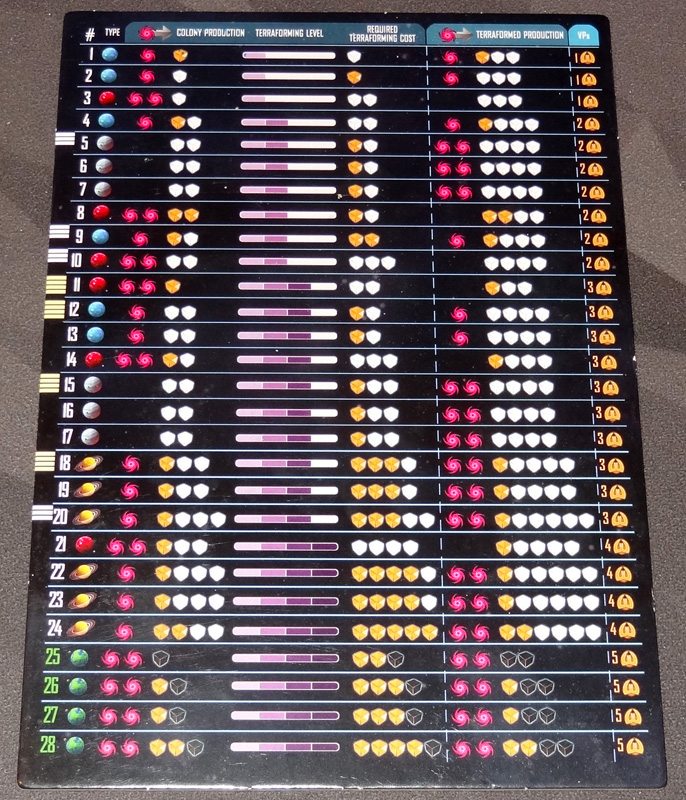
The game overall is colorful and has a lot of pretty bits, but there are also some parts of it that feel not quite polished. The quality of the component materials is good, though.
The back of the rulebook also has a section about the science of Kepler 3042, which is nice for those who like knowing the real-world background behind some of the game’s themes and mechanics. It explains things like the different planet types, the collaboration bonuses on the technology boards, and the fact that the “Clausius Pit” (where your burned resources go) isn’t actually a real thing.
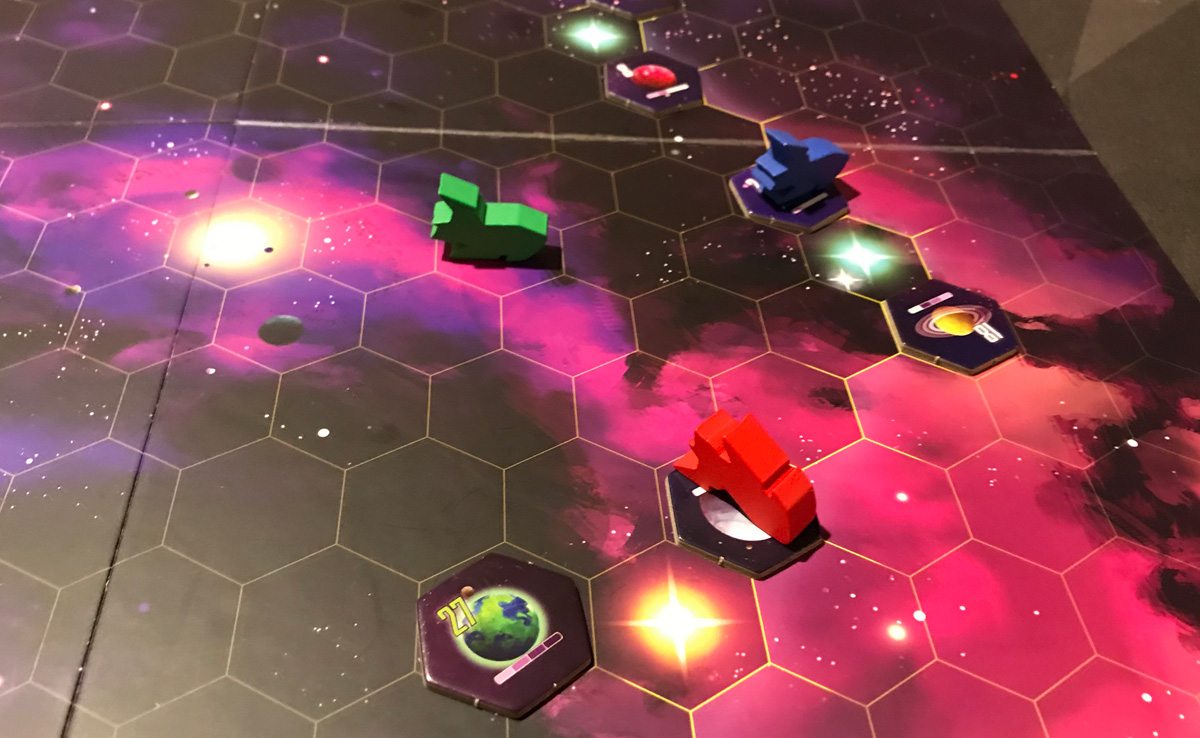
How to Play Kepler 3042
You can download a copy of the rulebook here.
The Goal
The goal of the game is to score the most points after 16 rounds through colonizing and terraforming planets, advancing your technology, and fulfilling secret objectives.

Setup
Place the board in the center, and place the deck of planet cards on the space provided. (The planet cards are in numerical order so you can find them as needed.) Shuffle the progress cards, remove two at random, and place the rest of the deck on the progress cards space. Place medal tokens on the two tracks where the icons indicate: purple colonial medals go on the colonial leadership track, and blue technology medals go on the technological leadership track. The round marker goes on the ‘0’ space of the turn order track.
The celestial body tiles are sorted out according to the planet summary chart–in a 2- or 3-player game, some of the planets are not used. In addition, you use one colonial target (the pink swirly icon) and one mine per player. All of these tiles are turned face-down and shuffled, and then seeded onto the board. Depending on the player count, you will use the single stars, binary stars, and trinary stars on the board. Each celestial object must be placed adjacent to a star (but not Sol, near the center of the board), and no two tiles should be directly adjacent to each other. Some stars will have more celestial bodies than others. Finally, turn all of the tiles in the short-range zone face-up. (The board shows short-range, mid-range, and long-range zones, according to their distance from Sol.)

Each player takes a planet summary board, a technology board, an action board, and all of the pieces of their color, including an Earth card. Each player also gets 7 energy, 7 matter, and 3 antimatter. Each player gets two secret objective cards and chooses one to keep. (You can decide whether to use standard or advanced objectives.)

Your player pieces are set up as follows:
- Place your action cube in the center of your action board (on Terraforming).
- Place five of your nation markers (discs) on your technology board at the far left side, and then choose two of them to move one space each.
- Place two nation markers on the main board, one next to each leadership track.
- Place 3 matter and 3 energy on your Earth card, and the rest of your resource cubes in the Resource Storage area on your action board.
- Your remaining 5 nation markers and 3 starships are set aside near your boards.
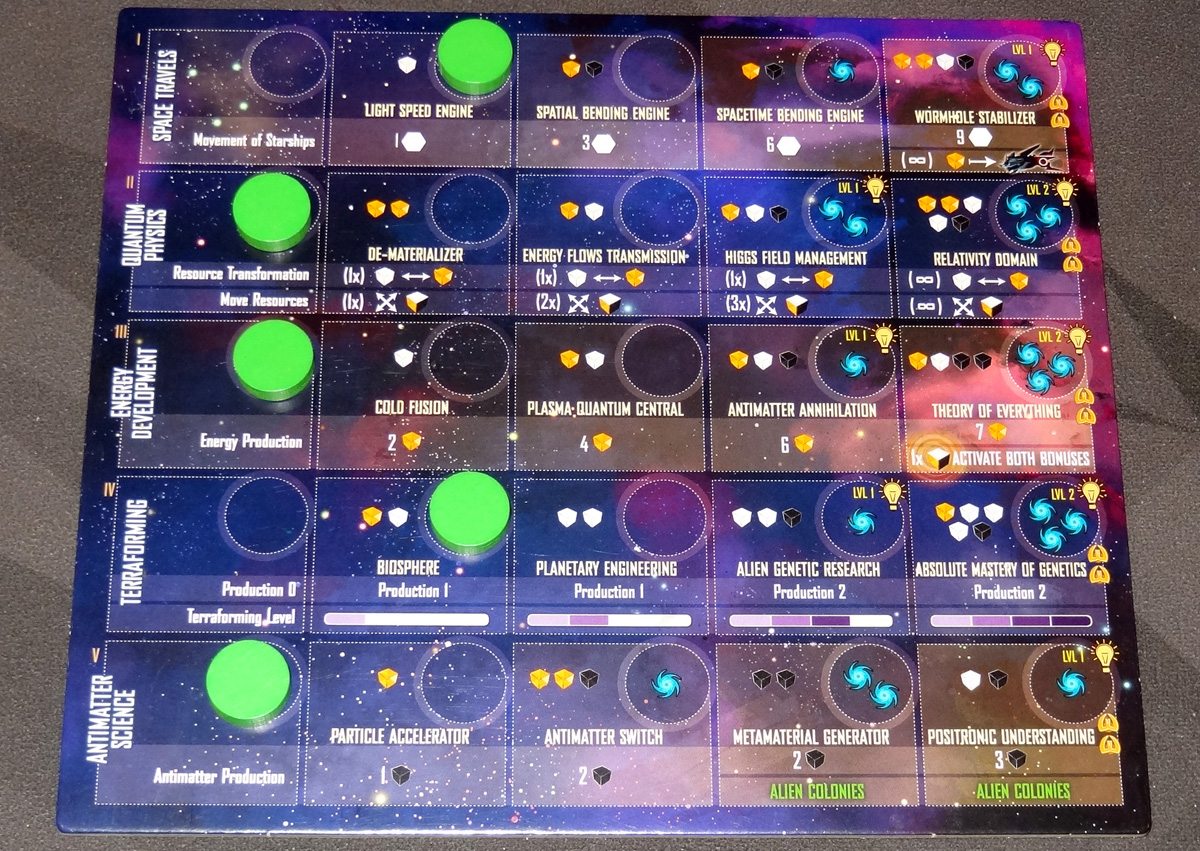
Finally, choose a player to be start player—the rules suggest the last player to read an article about astronomy—and give them the first player marker, the cardboard starship token.
Gameplay
Each round, you will reveal the top progress card and move the round marker forward, then each player will have a turn, and then during the cleanup phase the progress card is resolved and medals are awarded.

The progress cards are fairly self-explanatory: because they are revealed at the beginning and then resolved at the end, everyone can plan their actions accordingly.
On your turn, you take a main action, then up to two bonus actions. Then you may move your starships, and then withdraw your starships.
Important Concepts
When you spend resources, you take them off a planet card (at the beginning of the game, that would be your Earth card) and then put them into the Resource Storage on your board. When you produce resources, they go from Resource Storage onto the planet that produced them. You can also “burn” resources, which means to take it from a planet or Resource Storage and put it into your Clausius Pit on your action board. Burned resources can be “regenerated” to get them back, but there are limited opportunities to do so.

Your technology board has five different tracks, each of which can be increased independently, and will affect your ability to take various actions during the game.
- Space Travels determines how quickly your ships move. At the highest level, it costs less to build ships.
- Quantum Physics allows you to swap energy and matter, and lets you move resources between planets. The higher your level, the more you are able to swap and move.
- Energy Development determines how much energy you can produce with your Energy Storage action. At the highest level, it also lowers the cost for bonus actions.
- Terraforming determines which level of planet you are able to terraform, and also determines how many planets you may produce with in a single action.
- Antimatter Science determines how much antimatter you can produce with the Antimatter Generation action. Also, you must be at level 3 or 4 to colonize alien planets. (Other planet types may be colonized without this restriction.)
As you increase your technology, you will move up on the technological leadership track whenever you advance onto a space that has the blue swirl symbols. Also, if you reach a level that has a light bulb icon, any player who does not have the minimum level listed next to the light bulb automatically advances to that level. For instance, if you reach the highest level of Terraforming (Absolute Mastery of Genetics), there is a light bulb that says “Lvl 2” next to it; every player that is below Level 2 on that track (Planetary Engineering) would immediately get to move to that level.

There are two leadership tracks on the board, with medals on them, a score track between them, and some icons. Generally, you advance on the colonial track by colonizing or terraforming planets, and you advance on the technology track when you have advanced a technology to a level that shows blue swirl icons. Whenever you pass an icon on the track, you get that benefit—usually, producing either matter or energy. Each track has a special icon on the third space that lets you regenerate one resource. Whenever you pass a medal on a leadership track, that medal is placed on the progress card.
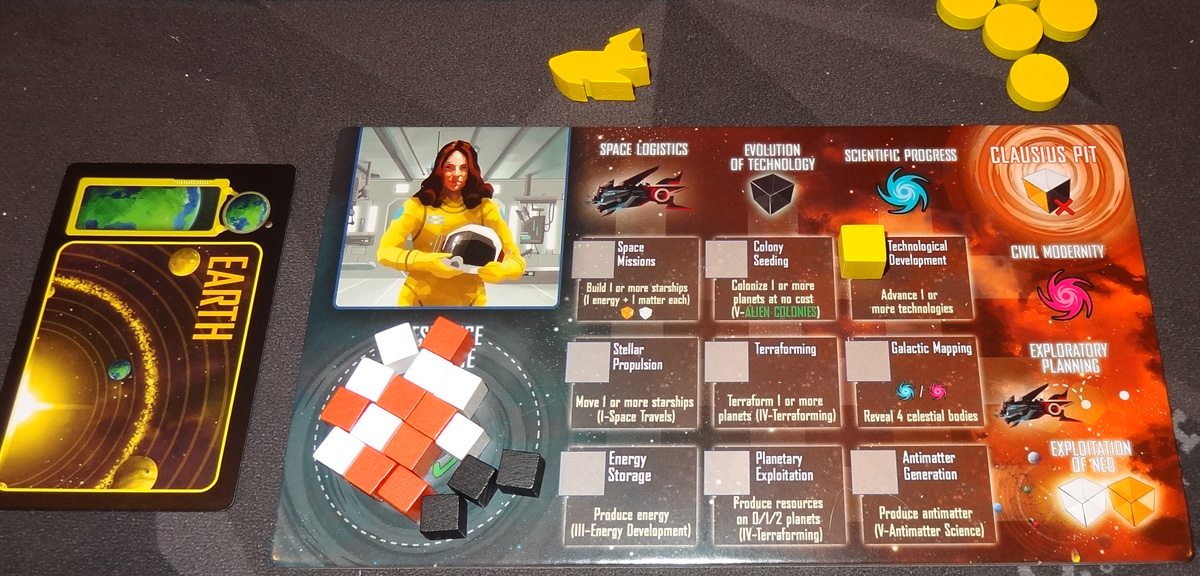
Main Action
Each of the nine spaces on your action board represents an action. You must always move your action cube to a different action—you may not take the same action two turns in a row. (You may move to any other action, not just adjacent actions.)
Here are the various actions you can take:
- Space Missions: build starships by spending 1 energy and 1 matter per ship. Ships are placed next to the planet where they were built (i.e., where the resources were spent). At the beginning of the game, place them adjacent to Sol.
- Colony Seeding: Withdraw any number of your starships from planets and replace them with nation markers. Take the matching planet card from the deck and place it in front of you, colony side up.
- Technological Development: Advance any number of your technologies on your tech board by spending the resources shown.
- Stellar Propulsion: Immediately move any number of your starships (according to the speed shown by your Space Travels tech).
- Terraforming: Terraform any number of your planets by spending the resources required, which must be on the planets that are being terraformed. Flip the planet cards over to the terraformed side.
- Galactic Mapping: Advance your marker on either one of the leadership tracks, and then reveal any four face-down celestial bodies on the board.
- Energy Storage: Produce energy according to your Energy Development tech, moving that much from your Resource Storage to any single planet of yours.
- Planetary Exploitation: Produce resources on your planets, moving them from Resource Storage to those planets. The number of planets you may exploit is shown on your Terraforming tech.
- Antimatter Generation: Produce antimatter on one of your planets, equal to your Antimatter Generation tech.
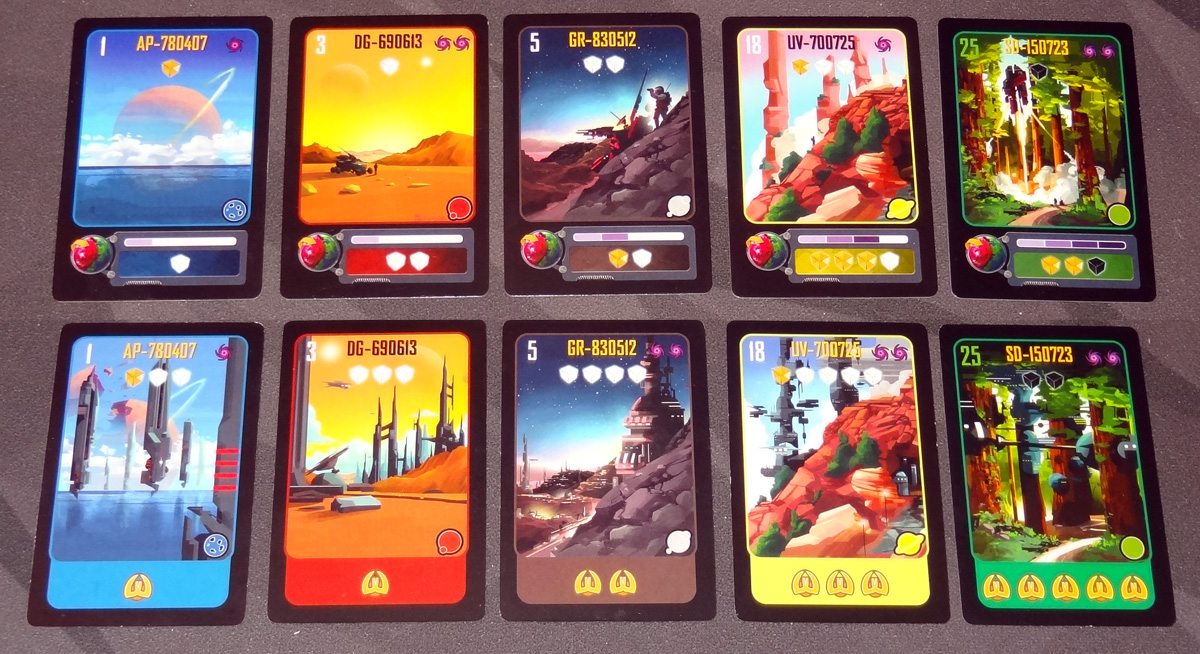
Bonus Actions
After resolving your main action, you may optionally take one or both bonus actions based on the column and row of your main action. The bonus actions are shown at the top of the three columns and to the right of the three rows, and you must burn a resource for each bonus action you take.
- Space Logistics: Build 1 starship immediately without spending additional resources (other than the burned one).
- Evolution of Technology: Produce one antimatter on any of your planets.
- Scientific Progress: Advance your nation marker on the technological leadership track.
- Civil Modernity: Advance your nation marker on the colonial leadership track.
- Exploratory Planning: Move any number of your ships up to two spaces each.
- Exploitation of NEO: Produce one energy and one matter on your Earth card.
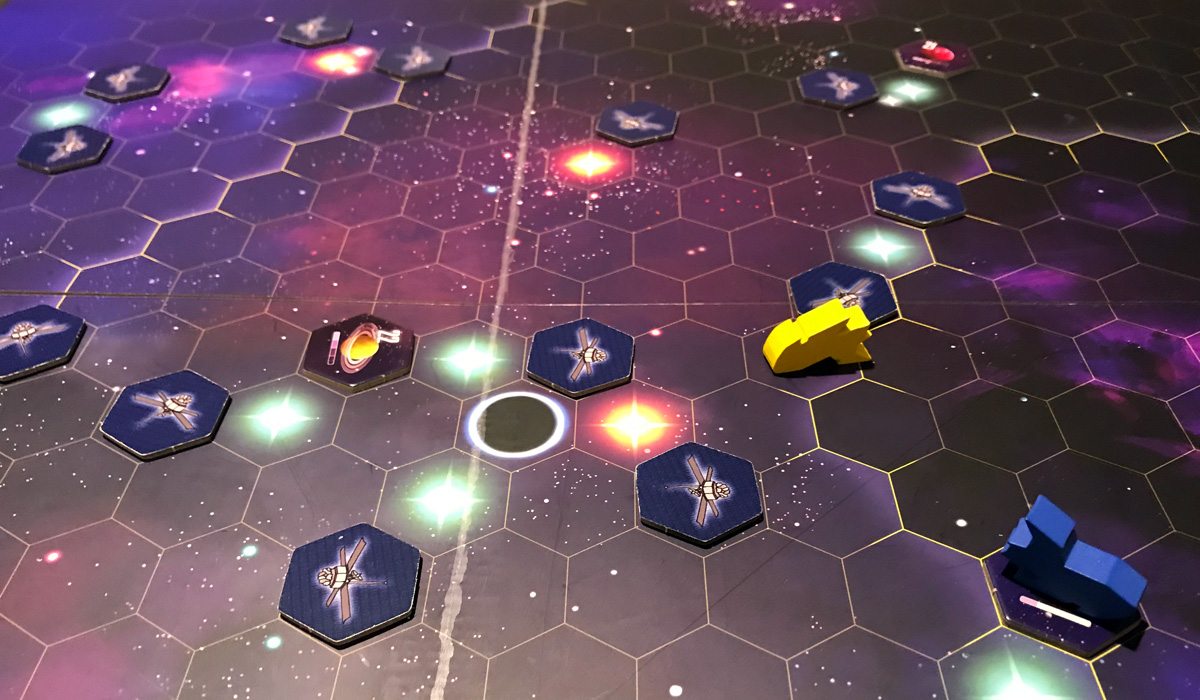
Move Starships
After your main and bonus actions, you may move each of your starships, according to the speed determined by your Space Travels tech. Starships may move through other ships but may not stop there; they may move onto face-up celestial bodies but must stop there. If you move onto a face-up colonial target (the pink swirl), you advance one space on the colonial leadership track and then discard that token, and you may continue moving. You may not move through stars or Sagittarius A*, the black hole.
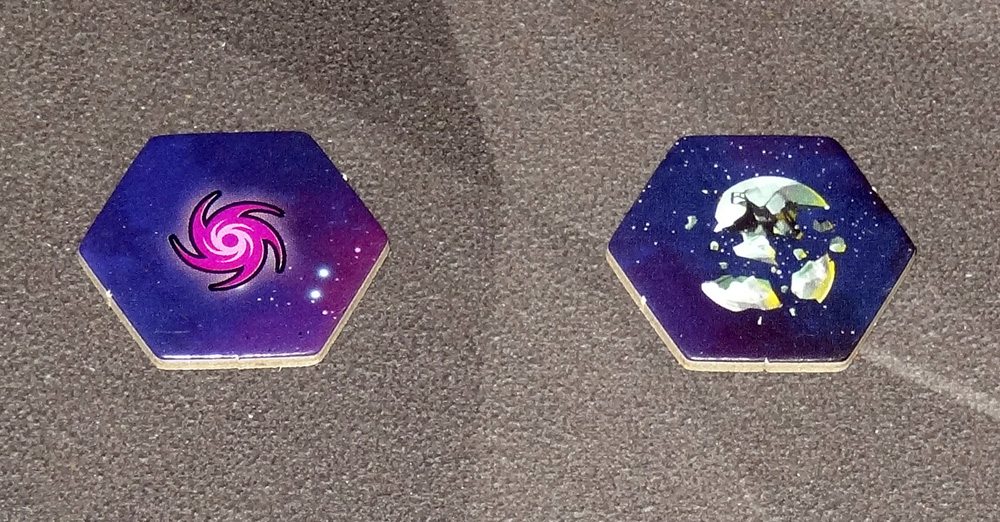
Withdraw Starships
You may remove any number of starships from the board and place them back into your supply. For each starship withdrawn from a mine, you may regenerate one resource from your Clausius Pit, putting it back into Resource Storage. Withdrawing starships from other locations does not give you any bonus, so it’s not typically done very often.
Cleanup Phase
First, the progress card is resolved—typically it will give a benefit for somebody, usually based on position on a leadership track or a technology level. In case of ties, everyone who is tied gets the benefit.
Then, medals are awarded. All of the medals that were placed on the progress card this round will be awarded to the player who is farthest ahead on the corresponding track. In case of a tie, use extra medals from the supply and award the full number of medals to all tied players.
Finally, the first player marker is passed clockwise, and a new round begins.

Game End and Scoring
The game ends after 16 rounds have been played (at which time there are no more progress cards to reveal).
Scoring is as follows:
- 1 VP for each antimatter you have on your planets (not in storage)
- 5 VP if you have colonized all five types of planets
- 3 VP if you have colonized at least three planets of the same type
- 2 VPs for each starship on a mine
- 2 VPs for each technology that reached the highest level
- 1 VP for each leadership medal
- 1 VP per colonized short-range planet, 2 VPs per colonized mid-range planet, 3 VPs for each colonized long-range planet
- VPs based on your positions on both leadership tracks
- VPs for your terraformed planets (as shown on the planet cards)
- VPs for completing your secret objective
There is a scoresheet for helping you keep track of the various items. The highest score wins, with ties going to the player who has terraformed the highest number planet.
Solo Play
There are solitaire rules available, set up as a series of five campaigns, with a limited ghost player. Each campaign has four levels—you must complete all four levels in order to win the campaign. Each level adds an assigned objective card; to pass the level, you must reach all of the previous objective cards in addition to the current one. You also must reach a minimum score for that level.
The ghost player does not take any actions, but instead advances periodically on the two leadership tracks and the tech tracks in order to compete with you for progress cards and medals.

Why You Should Play Kepler 3042
Kepler 3042 is what I would call a 3X game (though it doesn’t bill itself as such): it has Exploration, Expansion, and Exploitation, but not Extermination. You flip over tiles to find out what they are, build your fleet of starships and colonize planets, and manage your resources to improve your technology—all without fighting. It truly is a space race, not a space battle.
What that means, in practicality, is that there isn’t as much direct player interaction in the game. Your economy is closed: the resource cubes that you start the game with are also the cubes you’ll end the game with (though some might be burned in your Clausius Pit), so some of the game is knowing how to juggle those limited resources and get them to the right places so you can spend them. You can move through other starships but you can’t end in the same space, which means if somebody gets to a particular planet, there’s no way to remove them: best just to move on and find another planet to colonize. There’s even that collaborative aspect in the tech tree, where if one player advances much further ahead, it pulls other players up with them—that’s not something I’ve often seen in a competitive game.
So the game definitely feels like it has a sort of socialist image of the future, a world in which humanity has managed to stop killing each other and has decided to share technology (in a limited fashion) in a race to the stars. Some of the progress cards even have titles that add to that theme: “Agreement on Terrestrial Resources,” for instance, which allows players who are behind on the leadership tracks produce resources for free. So your political bent might have a bearing on whether you enjoy the theme of the game, whether you see it as optimism for a peaceful, egalitarian future, or liberal propaganda in favor of welfare. The effect of the progress cards can be interesting, because if you know at the beginning of the round that the person furthest behind in a particular technology will get a bonus, you have to decide whether it’s worth forgoing a tech upgrade just to get that bonus. Some of the progress cards reward the leaders, too, so you don’t always want to be at the back of the pack.
The first time I played Kepler 3042, I felt pretty lost at the beginning of the game: even before the game starts, you’re told to choose two technologies to advance for free, but if you haven’t played, you don’t really know which ones to take! It would have been nice for the rules to suggest two to try: for instance, I’ve discovered that if you don’t increase your Space Travels, then your ships aren’t going to move at all until you advance that tech. On the other hand, some of the technology requires more resources to get to Level 1, so starting with those can save you a few resources down the road. I’ve been experimenting with different starting tech each time I play to see how things shake out.
It’s also a game that starts off slowly and then ramps up significantly. You can colonize up to five planets during the course of the game, but during the first half of the game that feels like an impossible task. You’ll have to get your ships onto a planet to use the Colony Seeding action. Oh, but first you need to fly those ships there, so you’ll need to invest in your Space Travels tech. And build some ships. To do that, you’ll need resources. How do you get resources? Well, you’ll probably need to produce some energy (using your Energy Development tech) and then, if needed, convert it to matter (using your Quantum Physics tech). Right, and don’t forget to do some Galactic Mapping so that you can actually find some planets to land on. After you’ve colonized it? Time to terraform … which means you need to work on your Terraforming tech. Which means you need more resources.
But, hey, nobody said rocket science was easy.
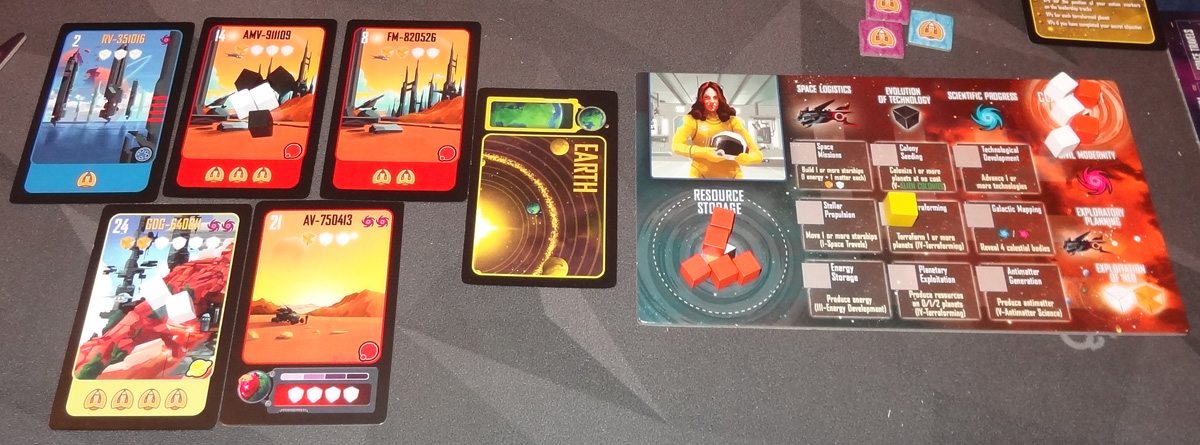
Part of the trick is figuring out the flow of the game, sort of a logistical puzzle. Do you build slow ships early, and work on your other tech and resources while they’re in flight? Or do you try to max out the speed on one ship, send it to a faraway planet, and then build more ships on that planet? When is it worth it to burn resources for the bonus actions? Is it worth trying to get them back?
It’s hard to succeed without doing at least a little of everything. It’s hard to upgrade your tech to the points-scoring levels if you haven’t colonized any planets, because some of them will let you produce more resources. But it’s also hard to colonize a lot of planets if you haven’t upgraded your tech. The order of operations can be a bit of a brain-burner, which is also what makes the game satisfying: when you get everything lined up and terraform a planet, you really feel like you’ve accomplished something significant. In most of the games I’ve played so far, even most new players have managed to colonize 3 or 4 planets by the end of the game, with a few reaching 5 planets. With the variety of sources to get points, there’s not one clear path to victory that I can see yet, so I’m looking forward to playing it some more to try out other approaches.
The game can be long, with the estimated 2 hours for a 4-player game, but I think it could be significantly shortened with experience. In particular, because the primary conflicts occur if two players are both moving for the same planet, in many instances turn order isn’t important, and you can plan out most of your turn for the round at the same time as everyone else.
The important question, though, is is it fun?
Yes, it’s fun—for the sort of gamer who enjoys a good puzzle, who likes playing with logistics and long-term planning. At the beginning of the game, sixteen rounds seems daunting. By the end, you’ll find yourself wishing you had just one more turn.
I like the way that your improved tech and expanding empire allows you to increase your reach and productivity, even though each turn is basically taking a single action. When you’re making a final push for the finish line, you can start burning up resources for those bonus actions, knowing that you won’t really need them anymore once the game’s over. It’s a game about maximizing efficiency and racing to the stars, colonialism minus the troublesome politics often associated with it. (because the alien planets are abstracted and conflict-free)—a utopian future indeed.
I don’t actually play a lot of solo games, so I admit that I have really given the solo game a shot. If I do play through some of the campaigns, I’ll report back!
If you like space exploration games, check out Kepler 3042. It may not be for everyone—particularly if you love space combat—but you might be surprised. In this game, your biggest obstacle to success may be your own poor planning! For more about the game, visit the Renegade Games website.
Click here to see all our tabletop game reviews.
If you’d like to stay up-to-date with all of our tabletop gaming coverage, please copy this link and add it to your RSS reader.
Disclosure: GeekDad received a copy of this game for review purposes.
